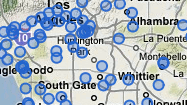Teacher responses to the 2010 release
The following is a list of teacher responses to their "value-added" ratings during the intial release in 2010. See the most recent responses »
The Times gave LAUSD elementary school teachers rated in this database the opportunity to preview their value-added evaluations and publicly respond. Some issues raised by teachers may be addressed in the FAQ. Teachers who have not commented may do so by contacting The Times.
|
|
 Delicious
Delicious
|
 Digg
Digg
|
 Facebook
Facebook
|
 Twitter
Twitter
|





I felt shocked, incredulous, saddened, embarrassed, and disappointed upon seeing this. My first reaction was of wanting to disavow such findings, wishing I could have actual data for my students from those few years. I thought about possible reasons for such a poor showing (some of my own doing and some not), such as: my last 3 years are not reflected, during those few years that are I had two family leaves and a major surgery placing me less time in those classes, at least one of those classes had the disadvantage of being a combination grade class. However, the bottom line is that none of this was the fault of those students. They deserved better.
I'll reflect on my teaching as I constantly do and I'll always strive to better help my students. I believe in my ability and my dedication but this will certainly make me look deeper into my teaching practices.
August 24, 2010 at 4:44 p.m.
I care deeply about all of my students. This is not an accurate reflection of my teaching effectiveness. It doesn't measure how I touch the lives of the children I teach every day. I instill a love of learning in my students. I teach them to be critical thinkers. I inspire them, encourage them and motivate them. I am helping to raise well rounded children-body, mind and spirit. As a nation, we need to come together with our teachers, parents and community to produce amazing human beings and productive citizens, not just good test-takers. It is true that we need to improve the education in the USA, however giving more tests is not the answer. If our main focus is on teaching our children to be good at taking tests, what will happen to our creaters, inventors, builders, artists and scientists? Be careful what you push for. Lastly, I think that publishing my full name and place of work is a violation to my safety, my rights and totally unconstitutional.
August 24, 2010 at 3:35 p.m.
If a reporter at the Times was only evaluated on his or her spelling would that give a clear and accurate picture of the reporter's skills? While I agree that data from testing is information that can be used to evaluate a teacher's skills, it is only one piece of the puzzle. I am concerned that readers will only look at this published evaluation and define who that teacher is and what goes on in the classroom based solely on these rankings. There are many pieces of the puzzle that are integral into educating and assessing our children. We short change all teachers and our children by basing how well we are all doing on just a standardized test.
August 24, 2010 at 8:33 a.m.
(First, a correction: I taught fifth grade at John B. Monlux Elementary for two years, 2005-06 and 2006-07. In April through June, 2008, I was a substitute teacher at Riverside Drive Elementary, in a Special Ed class of five children, none of whom took the CST. Therefore, I should not be listed as a teacher at Riverside. My comments on this subject are below.)
One factor that I have not seen emphasized in the discussion on this issue is the fact that teaching is a difficult profession, and that there is a learning curve. Unlike in other professions (law and medicine, for example), teachers in their first year are placed in a classroom the same as those with many years of experience, and are expected to perform to the exact same standards. While some teachers are "naturals", most need support during their early years. Many experienced teachers state that it took them 3-5 years to feel like they knew what they were doing; this was emphasized in a Times article earlier this year. Acknowledging this learning curve leads to questioning LAUSD's 2-year probationary period. It doesn't make sense to decide about tenure during a period when many teachers are still learning the ropes.
The fact is that new teachers are likely to be less effective than experienced ones. To make teaching desirable as a profession, the emphasis should be on providing effective, in-class support to help new teachers succeed. This would also support student achievement, which is the ultimate goal.
August 24, 2010 at 8:20 a.m.
I have always felt that "value added" was one way of looking at data that we failed to do. Generally, in professional development meetings we would compare cadre of students to cadre of students. I would be interested to see my scores for each individual year. During my 6 years at Dorris Place, I taught 4 different grades (5, K, 4, 4, 4, 3) respectively. I welcome the opportunity to learn and grow from these results, and to have discussions about what impact different factors have on scores. For example, how many years have those teachers in the top half of the effectiveness category been teaching that grade level? Are they "forced" to teach Open Court exclusively? What level of proficiency (Far Below Basic, Below Basic, Basic, Proficient, Advanced) are the "effective" teachers' students moving from? Is it easier to move students from one category or the other?
As for my scores, when I taught 5th grade, it was my first year in elementary school. It was a class of thirty, with more than three challenging students. My first year in 4th grade, I had 21/28 ELD students, most being level 1 or 2. There was growth that year. Second year of 4th grade I had 11/28 RSP students. My third year was probably the most successful. In general, 4th grade is difficult for student and teacher as class size goes up from 20 to 30. My 1 year in 3rd grade I taught gifted students. Yes, their scores did go down. For example, several students who earned perfect scores in the 2nd grade (where both sections of the CST are READ to students) missed 1, 2, or 3 questions. By the way, 3rd grade is the first year students read the test on their own.
Given my "defense" above, should I be fired? Or should we as a district look at those who are successful and see what they are doing that works. The scores only indicate that something is going on. What that is requires more than a number and a written explanation for the newspaper.
August 23, 2010 at 11:10 p.m.
Although I do strongly feel that parents need to have access to student testing data, I believe it needs to come from the school site in order for it to be as accurate as possible. For example, the LA Times is analyzing testing data for students enrolled in my class, but for the past two years the teachers in my grade level and I have collaboratively developed an instructional program based on student needs and not on our individual class rosters. This means that I have not provided instruction for students on my class roster in the areas tested by the CST so the data for my students does not effectively measure my performance as a teacher. Two years ago I only taught mathematics to 70 third grade students which means the students on my class roster received language arts instruction from another teacher and yet their CST test scores in Language Arts are being applied to me by the LA Times. I do understand that it would be impossible for the LA Times to know this information, but I also know that this happens frequently at schools which makes their evaluation system faulty in my case and in the case of many other teachers.
August 23, 2010 at 11:06 p.m.
I work with students that have the following special education eligibilities:
1. mild-moderate specific learning disabilities
2. mild-moderate mental retardation
3. mild to moderate autism
All of my students have made great academic progress as measured by their Individualized Education Plan (IEP) goals and objectives and other intervention benchmarks. My students parents have been extremely satisfied and impressed with the academic growth their children have made. All of the administrators that I have worked with have been very supportive and have given me constructive feedback and positive evaluations. Because the science of value-added modeling has not included and specifically addressed special educators, a research-derived model for these teachers does not exist. Thus far, the research literature on challenges in using standardized test scores of students with disabilities for the purposes of measuring growth is limited. Small student samples commonly associated with special education produce results that are statistically less reliable(Amrein-Beardsley,2008)
Reference:
Amrein-Beardsley,A.(2008).Methodological concerns about the education value-added assessment system.
Educational Researcher,37(2), 65-75
August 23, 2010 at 10:47 p.m.
Surely, within my scores you factored out the 20 - 30 of my students that received RSP services doing this time span, the students who should have received RSP services and did not, and my students that were retained. In terms of the Language Arts scores surely you had a method whereby you factored in the number of second language learners who receive little or no support from home because their parents speak little or no English.
This is such an unfair picture of the work that I do, and the personal finances I expend to provide my students with the necessary tools to advance their education.
We will be canceling our subscription to your paper.
C. Williams
August 23, 2010 at 10:43 p.m.
I am a retired 3rd grade teacher, but was still teaching during the "value-added" years. I do not think that publishing/ or using the test results is a true basis for teacher effectiveness. Unless each third grade teacher is given children of the exact abilities , attention spans, comfort levels when taking a test, etc., the individual teachers should not be penalized by value-added scores. My experience of 41 years in LAUSD gave me the opportunity to interact with children of many different language and economic backgrounds. Many children are just as gifted in the arts and social interactions, but do not necessarily do well on the structured tests which are presently being used. I found that in my last years of teaching, it was all about the tests and it became less of an opportunity to encourage creativity and to be a creative teacher.
I acknowledge that there are teachers that probably need to be in another profession, but an update in evaluations by principals would certainly help.
What happens when the teacher data is published and only 30 children can be in "Mr. Most Effective"'s class? How will the other parents/teachers feel? Will there end up being a lottery to see who gets into "Mr. Most Effective"'s class? Many teachers are quite gifted and encourage children to thrive in important ways other than taking a standardized test. Some type of middle road needs to be in place which includes some testing and some on teacher observation.
I feel that principals should be given a better/faster way to root out the teachers that aren't suited to teaching. They have tremendous obstacles to face just to remove an ineffective teacher, often taking a whole school year before the teacher is "transferred".
Where is the parental responsibility to help encourage children to do homework, pay attention, respect for teachers, etc.? All these factor in to how well a child will do in school and on any test.
Thank you.
Kay W. Fong
Thank you.
Kay Fong
August 23, 2010 at 4:32 p.m.
I felt stressed for weeks hearing about the publication of my CST scores as an "absolute" measure of the value I add to my students' education. I felt extremely relieved to see my high scores. However, this does not change my opinion standards based tests should never be the sole measure to evaluate teachers or to provide merit pay. It would take a book like Diane Ravitch's to explain why. Let me provide a few examples. For my upcoming 2010 scores, I had an average of 24 students, but transience changed the students I taught significantly over the year. 8 left my class and 8 new ones joined my class over the year. 1 boy was transferred from a 2nd grade class where he'd been retained into my 3rd grade class in January. Another was transferred to my class from another 3rd Gr. teacher less than 2 months before the CST--a child receiving a majority of his daily instruction from Special Ed. and Intervention teachers, not myself. Yet, their names will appear on my next CST list. At least 3 higher performing students left my class, one a few before the CST, and although they spent most of 3rd Gr. with me, their scores will appear on another teacher's list. I recall a year where 3 students' names with failing scores mistakenly appeared on my list--kids I'd never seen nor had in my classroom. There are so many challenges we teachers face and so much more we do than give tests. Posting only CST scores without in depth investigative reporting of what happens in schools to provide comprehensive and complete data is irresponsible, biased data, and hurts teachers, therefore students. I am against the publishing of CST scores. Laura McCutcheon, a 3rd Grade Teacher (National Board Certified and Bilingual, Multicultural Early Childhood Educator & Teacher Leader, Mentor/ Coach, and Trainer)
August 23, 2010 at 2:36 p.m.